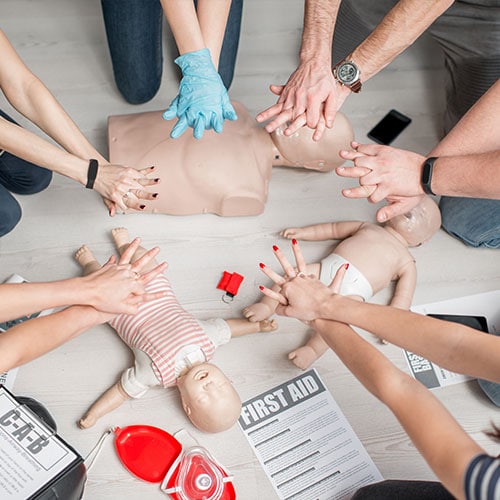Introduction
In our hectic globe, emergencies can strike without caution. Whether it's a small injury, a medical emergency situation, or a serious scenario, recognizing exactly how to give emergency treatment can make all the difference. This is where a First Aid course enters into play. Many people may wonder what they can acquire from such training, and this short article aims to clarify that.
By register in a First Help and mouth-to-mouth resuscitation course, you don't just learn more about wrapping injuries or executing CPR; you outfit on your own with invaluable skills that can save lives. So, what exactly will you find out in a detailed program? Allow's dive into the details.
First Help Essentials: What You'll Find out in an Extensive Course
Understanding First Aid
What is Initial Aid?
First aid describes the first help provided to someone struggling with an injury or ailment up until professional medical help arrives. It encompasses numerous methods and abilities varying from easy wound like lifesaving techniques like mouth-to-mouth resuscitation (Cardiopulmonary Resuscitation).
Importance of First Aid Training
Why Needs to You Take a First Aid Course?
Taking a First Help course is important for several reasons:
- Confidence: Recognizing exactly how to react in emergency situations can impart confidence. Life-Saving Skills: The ability to carry out CPR or aid with choking can save lives. Career Improvement: Many careers need certification in first aid. Community Responsibility: Learning means you can assist others effectively.
Overview of CPR
What is CPR?

CPR, or Cardiopulmonary Resuscitation, is an emergency situation treatment carried out when somebody's heart beat or breathing has actually quit. It incorporates chest compressions with rescue breaths to keep blood circulation and oxygenation up until specialist assistance arrives.
The Structure of a Comprehensive Emergency Treatment Course
What Does an Emergency treatment Course Include?
An all-around First Help and CPR course commonly covers the complying with subjects:
Introduction to First Aid Legal and Ethical Considerations Scene Safety Basic Life Assistance (BLS) CPR Techniques Choking Relief Wound Care Management Burn Treatment Managing Shock Recognizing Medical Emergencies Using an Automated External Defibrillator (AED)Legal Aspects of First Aid
Are There Legal Ramifications Associated With Providing First Aid?
Yes, giving first aid does carry legal obligations called "Good Samaritan regulations." These legislations safeguard people that assist others in emergencies, offered their actions are practical and not reckless.
Scene Safety: The First Step
How Do You Make sure Scene Safety?
Ensuring scene safety involves examining the atmosphere before approaching the target:
- Look for potential threats (traffic, fire). Make certain it's safe for both you and the victim.
Basic Life Support (BLS)
What Duty Does BLS Play in Emergency Situation Situations?
Basic Life Support consists of the basics of maintaining life functions till additional medical help shows up. This area covers crucial skills such as:
- Checking responsiveness Activating emergency services Performing top notch upper body compressions
Advanced CPR Techniques
What Are Advanced Techniques Covered in CPR Courses?
Advanced techniques might consist of:
- Two-rescuer CPR Use of barrier gadgets for rescue breaths Special considerations for babies and kids
Choking Alleviation Techniques
How Do You Aid A Person Who is Choking?
Choking relief includes two important techniques:
Hobart CPR Course Near Me The Heimlich maneuver for adults. Back strikes and upper body drives for infants.Wound Care Management
How Do You Correctly Manage Wounds?
Effective wound management involves:
- Cleaning the wound with saline or tidy water. Applying antibiotic ointment. Covering it with sterilized dressings.
Burn Treatment
What Are Effective Approaches for Treating Burns?
Burn treatment differs by degree:
Cool the melt under running water. Cover it with non-stick dressings. Seek clinical interest for severe cases.Managing Shock
How Is Shock Acknowledged and Treated?

Recognizing shock includes looking for signs and symptoms like pale skin, quick pulse, or complication:
Lay the individual down. Elevate their legs unless there are injuries protecting against this. Keep them soothe till aid arrives.Recognizing Medical Emergencies
What Types of Medical Emergencies Need To You Understand Of?
Common clinical emergencies include:

- Heart strikes Stroke Severe allergies Recognizing these conditions aids you act quickly.
Using an Automated External Defibrillator (AED)
How Do You Utilize an AED Correctly?
Using an AED entails transforming it on, attaching pads according to pictures on the tool, and following voice motivates carefully.
Importance of Constant Learning
Why Is Continuous Learning Important in Emergency Treatment Training?
Continuous understanding guarantees you remain upgraded on ideal techniques and brand-new procedures in first aid care.
FAQs Concerning First Aid Courses
What Is Consisted of in a Criterion First Aid Course?- A typical program generally covers basic life support, injury administration, choking relief techniques, and legal considerations.
- Most programs vary from 6 hours to 16 hours depending on the deepness of material covered.
- Yes, upon successful completion of most courses, individuals obtain a first help certificate, which is normally valid for two years.
- Yes! Lots of companies use online programs that give flexible understanding atmospheres while still being effective.
- Absolutely! Hands-on practice is vital for mastering abilities like chest compressions and utilizing AEDs effectively.
- Generally, there are no age limitations; nonetheless, participants should be mentally skilled to learn these life-saving skills effectively.
Conclusion
Enrolling in an extensive emergency treatment course outfits people with essential expertise that can save lives during emergencies-- whether in the house, job, or out in public rooms! From understanding standard life assistance procedures such as mouth-to-mouth resuscitation to learning how to handle wounds appropriately or acknowledge indications of shock-- these courses provide vital training that any individual can profit from!
As we navigate via our daily lives filled with changability-- what better means than preparing ourselves with expertise gained from organized training sessions focused on conserving lives?
In final thought-- if you're considering occupying any kind of kind of first-aid training-- never ever hesitate! Outfit on your own today with these effective devices because preparedness truly makes all the difference when every second counts!